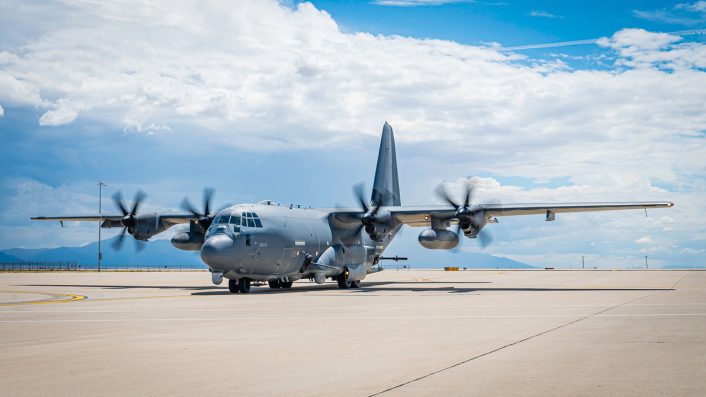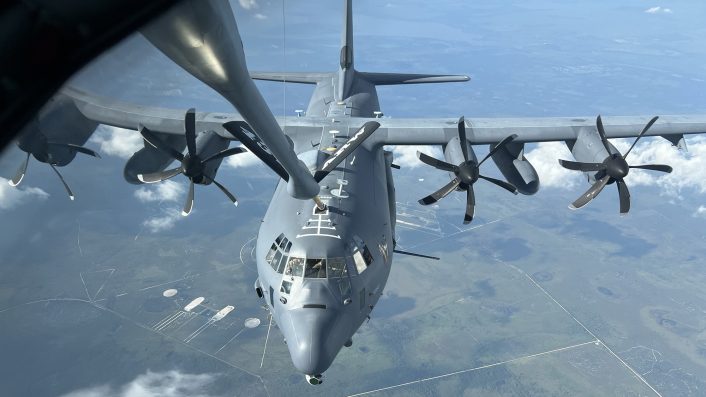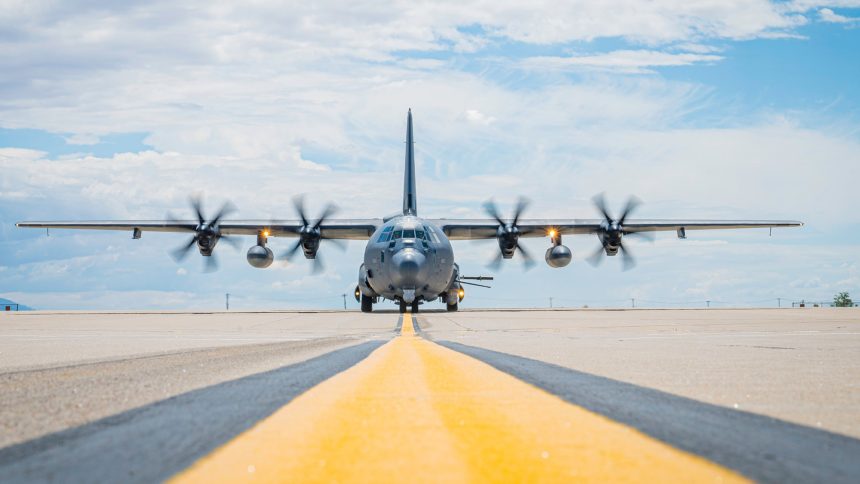The arrival of the AC-130J Ghostrider at Kirtland Air Force Base signifies a major advancement for the U.S. Air Force’s special operations training and capabilities.
On Sept. 5, 2024, the 58th Special Operations Wing at Kirtland Air Force Base, New Mexico, celebrated a significant milestone with the arrival of the AC-130J Ghostrider gunship. This event marked the official introduction of the AC-130J into Kirtland’s distinguished lineup of aircraft, underscoring the base’s evolving role in the U.S. Air Force’s special operations training and mission readiness.
The arrival of the AC-130J is just the beginning. In the coming months, five more Ghostrider gunships will be stationed at Kirtland, accompanied by 299 active-duty Airmen and their families, who will become integral members of Team Kirtland. This move supports the Air Force Special Operations Command’s (AFSOC) strategy to realign AC-130J training under the Air Education and Training Command (AETC), consolidating initial and mission qualification training at Kirtland. This consolidation is expected to streamline training processes and improve operational efficiency.
“The AC-130J has a legendary record stretching back to the Vietnam War to its current role,” stated Col. Joshua Jackson, Deputy Commander of the 58th Special Operations Wing, highlighting the historical significance and ongoing legacy of the aircraft.

A Celebrated Ceremony with Distinguished Attendees
The arrival ceremony was a momentous occasion, attended by several notable figures, including retired U.S. Air Force Brigadier General Hanson L. Scott, Colonel Michael Power, Commander of the 377th Air Base Wing, Chief Master Sergeant Antonio Cooper, Command Chief of the 377th ABW, as well as numerous other distinguished guests from the 377th Air Base Wing, 58th Special Operations Wing, local Albuquerque civic leaders, Albuquerque Fire Rescue, and members of Team Kirtland. Friends and family of the Airmen also joined to witness this historic event.
The ribbon-cutting ceremony was performed by Col. Joshua Jackson, along with Patricia Marquez Knighten, a Team Kirtland Wingman, and Lt. Col. John Barringer, Commander of the 73rd Special Operations Squadron. This symbolic act represented the beginning of a new chapter for Kirtland as a central hub for AC-130J training and operations.
Benefits of the AC-130J Relocation
Relocating the AC-130J training to Kirtland is projected to bring several benefits. Primarily, it is expected to reduce both training and travel costs significantly, while also accelerating training timelines. The unique environment of New Mexico provides ideal conditions for comprehensive training, which will include six months of academic and simulator instruction. By consolidating training efforts at a single location, the Air Force aims to enhance efficiency and foster a more cohesive training environment.
As the AC-130J becomes an integral part of the 58th Special Operations Wing’s operations, this consolidation will support the broader goals of AFSOC, AETC, and Team Kirtland to advance the U.S. Air Force’s mission readiness. This collaboration among different commands underscores the Air Force’s commitment to optimizing its resources and streamlining its training processes.
The AC-130J Ghostrider
The AC-130J Ghostrider is the latest in a long line of heavily armed gunships, succeeding the AC-130W, AC-130U, and AC-130H models. Known for being the most heavily armed gunship in history, the AC-130J features a trainable 30mm GAU-23/A cannon and a 105mm cannon, along with hardpoints on its wings that can carry up to eight GBU-39 Small Diameter Bombs or AGM-114 Hellfire missiles. This diverse array of weapons allows the AC-130J to engage targets with precision and effectiveness, especially in low-light or adverse weather conditions. It plays a critical role in supporting ground operations, providing close air support to troops in contact, conducting armed reconnaissance missions, and engaging enemy targets.
The AC-130J gunship employs a unique tactical approach when using its cannons: the aircraft circles over a target area in a constant left turn, using its side-firing cannons to engage ground targets effectively. This tactic enables the gunship to maintain a consistent orbit path around the target while delivering accurate and sustained firepower. Its sophisticated sensors and targeting systems further enhance its combat effectiveness, allowing for precise targeting. The crew aboard the gunship coordinates to adjust the aircraft’s flight path and firing angles, ensuring that the cannons are effectively directed towards the intended targets on the ground.
This aircraft is a highly modified version of the C-130J, equipped with advanced features such as a two-pilot flight station with fully integrated digital avionics, dual inertial navigation systems, GPS, and the Precision Strike Package. The Precision Strike Package includes a mission management console, a robust communications suite, two electro-optical/infrared sensors, advanced fire control equipment, and precision-guided munitions delivery capability. The mission management system fuses sensor data, communication inputs, environmental information, order of battle, and threat intelligence into a common operating picture, enhancing the aircraft’s combat effectiveness.
The AC-130J’s ability to deliver a range of munitions with pinpoint accuracy, combined with its sophisticated sensor and communication suites, makes it a formidable asset on the battlefield. Its adaptability and power projection capabilities provide unparalleled support to ground forces, reinforcing its role as a crucial element in the U.S. Air Force’s special operations arsenal.

A Proven Track Record and Future Capabilities
The first AC-130J completed its developmental test and evaluation in June 2015, achieving initial operational capability in 2017, with full operational capability anticipated by 2025. The 73rd Special Operations Squadron at Hurlburt Field, Florida, became the first squadron to activate the AC-130J on February 23, 2018. The final, 31st AC-130J was delivered to AFSOC at Cannon Air Force Base in November 2022, marking the full complement of these aircraft for the command.
The AC-130J has already demonstrated its capabilities in combat.
On November 21, 2023, an AC-130J Ghostrider, designated AC-130J (s/n 18-5886), was tracked online participating in airstrikes against insurgent groups responsible for a missile attack on U.S. and Coalition personnel at Al Assad Airbase in Iraq. In this direct response, the Ghostrider effectively engaged the Islamic Resistance in Iraq, resulting in several casualties and at least three confirmed kills.
More recently, the Ghostrider has taken part in a SINKEX exercise during RIMPAC 2024. Gunships like the AC-130J are not designed for ship-sinking missions, as these tasks are better suited for manned aircraft like the F-16 or unmanned platforms like the Reaper. However, given their potential utility in littoral combat scenarios, they have begun to incorporate training for such missions, targeting small fishing vessel decoys, which are increasingly viewed as unconventional threats, potentially being used for secondary roles like surveillance, reconnaissance, and logistical support.
View this post on Instagram









